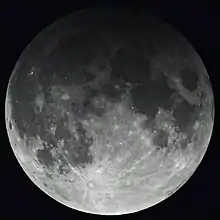| Partial eclipse | |||||||||||||
| Date | 4 April 1977 | ||||||||||||
|---|---|---|---|---|---|---|---|---|---|---|---|---|---|
| Gamma | −0.91483 | ||||||||||||
| Magnitude | 0.19289 | ||||||||||||
| Saros cycle | 112 (63 of 72) | ||||||||||||
| Partiality | 94 minutes, 45.6 seconds | ||||||||||||
| Penumbral | 262 minutes, 57.7 seconds | ||||||||||||
| |||||||||||||
A partial lunar eclipse took place on Monday, April 4, 1977, the first of two lunar eclipses in 1977. At maximum eclipse, a small bite out of the Moon should have been visible. The eclipse lasted for 1 hour and 34.76 minutes, with just 19.289% of the Moon in shadow at maximum.[1]
Visibilility
It was completely visible over North America, South America, Europe and Asia, seen rising over the Pacific and setting over the Middle East.
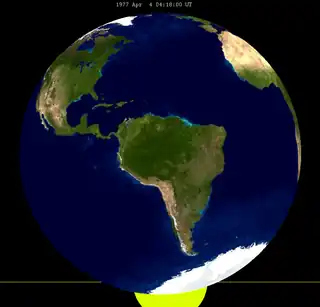
Related lunar eclipses
Eclipses in 1977
- A partial lunar eclipse on Monday, 4 April 1977.
- An annular solar eclipse on Monday, 18 April 1977.
- A penumbral lunar eclipse on Tuesday, 27 September 1977.
- A total solar eclipse on Wednesday, 12 October 1977.
Lunar year series
| Lunar eclipse series sets from 1977–1980 | ||||||||
|---|---|---|---|---|---|---|---|---|
| Ascending node | Descending node | |||||||
| Saros | Date Viewing |
Type Chart |
Gamma | Saros | Date Viewing |
Type Chart |
Gamma | |
| 112 | 1977 Apr 04 |
Partial |
−0.91483 | 117 | 1977 Sep 27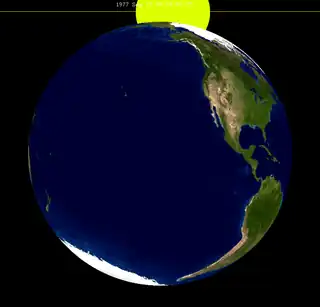 |
Penumbral |
1.07682 | |
| 122 | 1978 Mar 24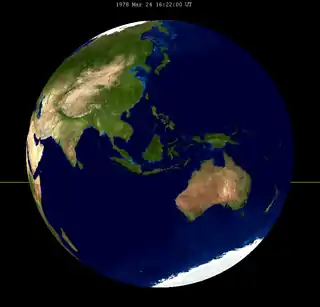 |
Total |
−0.21402 | 127 | 1978 Sep 16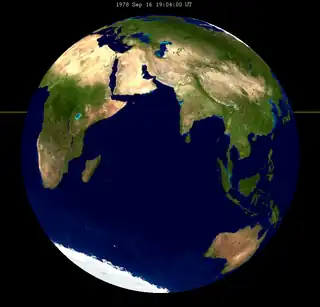 |
Total |
0.29510 | |
| 132 | 1979 Mar 13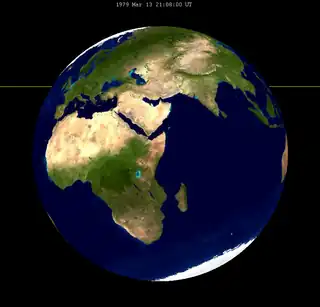 |
Partial |
0.52537 | 137 | 1979 Sep 06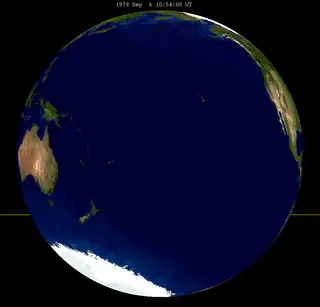 |
Total |
−0.43050 | |
| 142 | 1980 Mar 01 |
Penumbral |
1.22701 | 147 | 1980 Aug 26 |
Penumbral |
−1.16082 | |
| Last set | 1976 May 13 | Last set | 1976 Nov 06 | |||||
| Next set | 1981 Jan 20 | Next set | 1980 Jul 27 | |||||
Saros series
Lunar Saros series 112, repeating every 18 years and 11 days, has a total of 72 lunar eclipse events including 15 total lunar eclipses.
| Greatest | First | |||
|---|---|---|---|---|
| The greatest eclipse of the series occurred on 1490 Jun 02, lasting 100 minutes.[2] | Penumbral | Partial | Total | Central |
| 859 May 20 | 985 Aug 03 | 1364 Mar 18 | 1436 Apr 30 | |
| Last | ||||
| Central | Total | Partial | Penumbral | |
| 1562 Jul 16 | 1616 Aug 27 | 2013 Apr 25 |
2139 Jul 12 | |
There are 11 series events between 1901 and 2100, grouped into threes (called an exeligmos), each column with approximately the same viewing longitude on earth.
| 1905 Feb 19 | 1923 Mar 3 | 1941 Mar 13 | |||
 |
 |
 |
 |
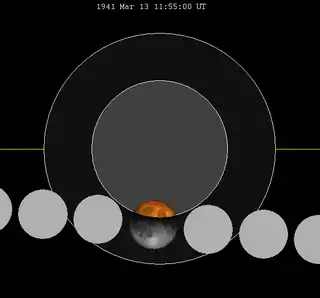 |
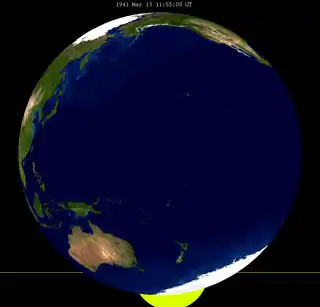 |
| 1959 Mar 24 | 1977 Apr 04 | 1995 Apr 15 | |||
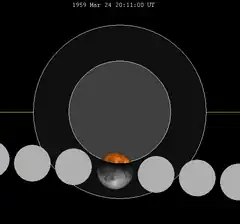 |
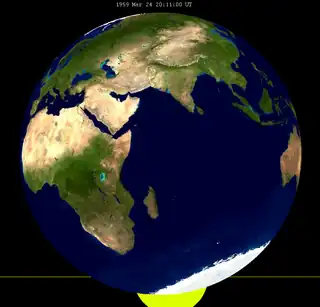 |
 |
 |
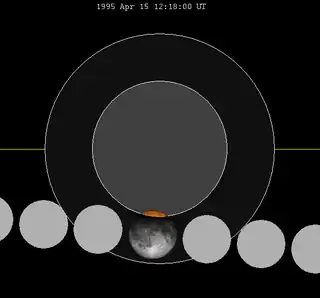 |
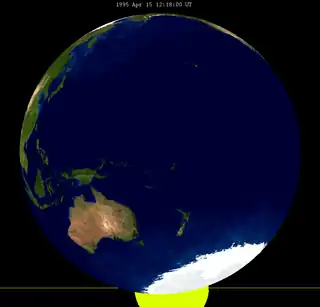 |
| 2013 Apr 25 | 2031 May 07 | 2049 May 17 | |||
 |
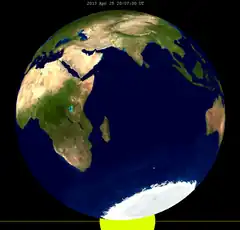 |
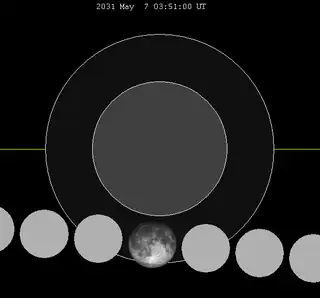 |
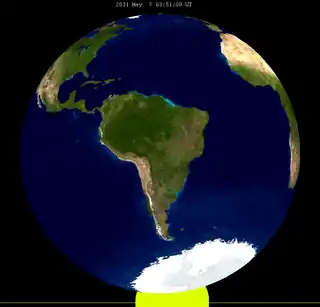 |
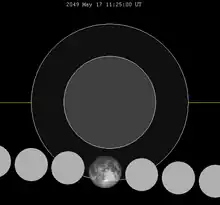 |
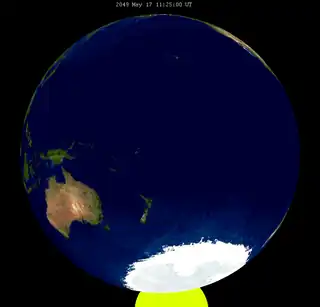 |
| 2067 May 28 | 2085 Jun 08 | ||||
 |
 |
||||
Half-Saros cycle
A lunar eclipse will be preceded and followed by solar eclipses by 9 years and 5.5 days (a half saros).[3] This lunar eclipse is related to two partial solar eclipses of Solar Saros 119.
| March 28, 1968 | April 9, 1986 |
|---|---|
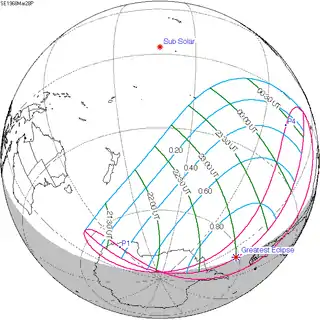 |
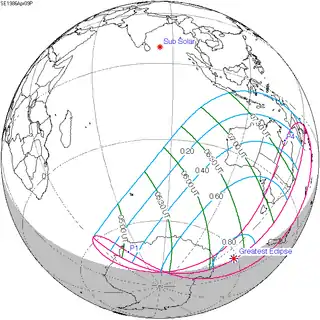 |
See also
Notes
- ↑ Hermit Eclipse: Saros cycle 112
- ↑ Listing of Eclipses of series 112
- ↑ Mathematical Astronomy Morsels, Jean Meeus, p.110, Chapter 18, The half-saros
External links
- 1977 Apr 04 chart Eclipse Predictions by Fred Espenak, NASA/GSFC
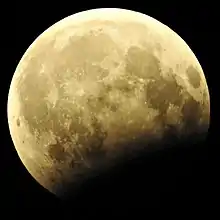
_(cropped).jpg.webp)
